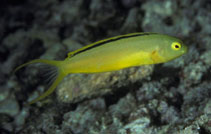| Family: |
Blenniidae (Combtooth blennies), subfamily: Blenniinae |
| Max. size: |
10 cm SL (male/unsexed) |
| Environment: |
pelagic-neritic; marine; depth range 0 - 16 m |
| Distribution: |
Pacific Ocean: apparently endemic to Tonga. |
| Diagnosis: |
Dorsal spines (total): 4-4; Dorsal soft rays (total): 27-28; Anal spines: 2-2; Anal soft rays: 17-18. Lunate caudal fin with elongated lobes in adults; yellowish green on head and dorsally on body, shading to light yellow ventrally; greenish yellow dorsal and anal fins, broad black stripe near dorsal fin base; caudal fin base and lobes greenish yellow with centroposterior part transparent with pale greenish yellow rays. Segmented caudal rays 11-12 (usually 11); lateral line terminating below 3rd to 7th dorsal soft rays (Ref. 54980). |
| Biology: |
Oviparous. Eggs are demersal and adhesive (Ref. 205), and are attached to the substrate via a filamentous, adhesive pad or pedestal (Ref. 94114). Larvae are planktonic, often found in shallow, coastal waters (Ref. 94114). |
| IUCN Red List Status: |
Least Concern (LC); Date assessed: 28 March 2009 Ref. (130435)
|
| Threat to humans: |
harmless |
Source and more info: www.fishbase.org. For personal, classroom, and other internal use only. Not for publication.

